Year 1911
In 1911, in anticipation of the Italian-Turkish War (also known as the Libyan War), the fleet of the Italian Royal Navy carried out landing exercises in Diano Marina in the Ligurian Sea.
Under the command of the Amiraglio Aubry, in addition to the units already mentioned above, came to Sanremo, the Battleships Vittorio Emanuele I, Regina Elena, Naples, Rome, Benedetto Brin, the Armored Cruisers Pisa and Amalfi, the Destroyer Cruiser (then Explorer) Coatit and sixteen Destroyers, including the Corazziere and the Lanciere.
It was the most numerous presence of naval units in roadsteads in Sanremo before the First World Conflict and it attracted many spectators, large and small!
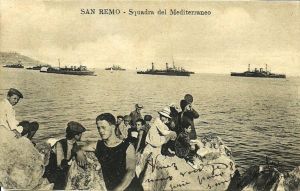 In the picture on the postcard we can see the Battleship Benedetto Brin, the Armored Cruiser Amalfi, the Destroyer Cruiser Coatit, the Armored Cruiser
In the picture on the postcard we can see the Battleship Benedetto Brin, the Armored Cruiser Amalfi, the Destroyer Cruiser Coatit, the Armored Cruiser 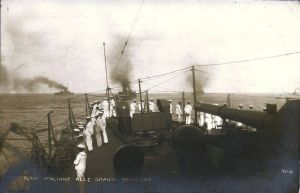 Pisa and some Destroyers of the Grenadier Class (or rather Soldier Class) lined up from right to left.
Pisa and some Destroyers of the Grenadier Class (or rather Soldier Class) lined up from right to left.
The Battleship at revolving towers Vittorio Emanuele I was built in the Shipyards of Castellammare di Stabia, launched in 1904 and entered service in 1908.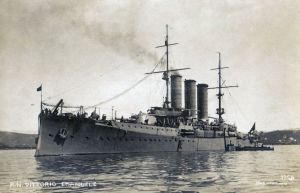
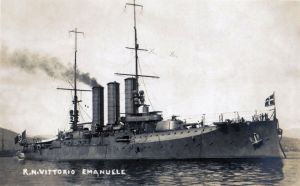 It was considered an excellent unit with characteristics well balanced between the need for less tonnage, maximum protection and armament power. It was built to effectively combat the new French Armored Cruisers but was faster than the English and French Battle Ships of the Epoch, and more armed than the Cruisers.
It was considered an excellent unit with characteristics well balanced between the need for less tonnage, maximum protection and armament power. It was built to effectively combat the new French Armored Cruisers but was faster than the English and French Battle Ships of the Epoch, and more armed than the Cruisers.
These Units were the forerunners of the New Battleships adopted by all Marines.
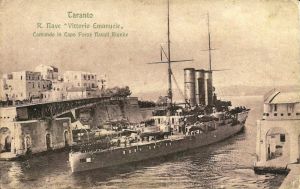 Originally equipped with 2 masts, following modernisation in 1912, one was removed.
Originally equipped with 2 masts, following modernisation in 1912, one was removed.
It took part in the Italo-Turkish War and the First World War.
From July 1922 it was classified as "Coastline Battleship" until the Radiation of 1923.
The Vittorio Emanuele I in Taranto is passing by the Ponte Girevole bridge that connects the Mare Grande with the Mare Piccolo.
At that time it was the headquarters of the Command in Capo delle Forze Navali Riunite.
(Features. Class Regina Elena... Displacement p.c. 14,137 tons. Max forced speed 21.36 knots... Steel Terni protection 50mm. (battery bridge) to 250 mm. (tower, towers, belt)... Armament: 2 Single pieces of 305/40 mm.; 12 twin pieces of 203/45 mm.; 16 single pieces of 76 mm.: 10 single pieces of 47 mm.; 2 machine guns; 2 torpedo tubes of 450 mm.).
The Battleship Regina Elena, Unit "Head of the class", was built in the shipyard of the Arsenal of La Spezia to be launched in 1904 and entered into service in 1907.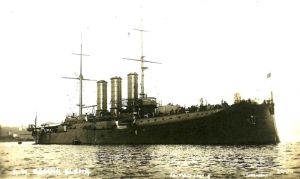
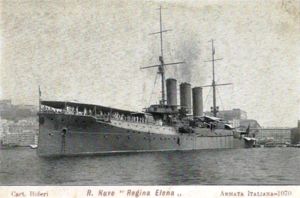 It took part in the Italo-Turkish War (Libyan War) and the First World War.
It took part in the Italo-Turkish War (Libyan War) and the First World War.
In the first post-war period it was used as a departmental flagship and as a school ship.
From 1927 it served as a Training Unit until it was cancelled from the Regia Marina Registers in 1932.
(Characteristics : Full load displacement 13,804 tons. Speed: 20.8 knots. Protection and Armament the same as the Gemella Vittorio Emanuele I°. (for Technical Notes the same as for Gemella Vittorio Emanuele I°).
The Battleship at revolving towers Napoli, also Regina Elena Class, was built in Castellammare di Stabia, launched in 1905 and entered service in 1908.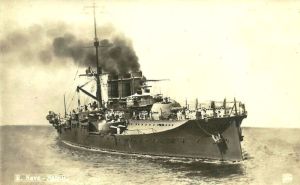
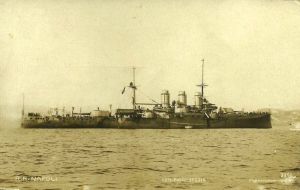 He took part in the Italo-Turkish War and the First World War.
He took part in the Italo-Turkish War and the First World War.
In 1926 it was cancelled by the Registers of the Navy and sold to the breakers.
It was dismantled in Savona in 1928.
(Dislocamento p.c. 13,995 tons. Max forced speed 22.40 knots. Protection and Armament the same as the Vittorio Emanuele I°. Technical notes the same as Vittorio Emanuele I).
The Battleship Benedetto Brin was built by the Shipyards of Castellammare di Stabia to be launched in 1901 and to enter into service in 1906.
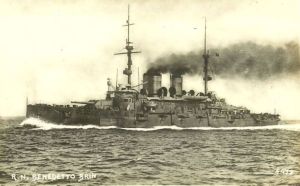 It was an Excellent Unit for its Speed, High Protection, Good Armament, Excellent Marine Quality combined with a more comfortable accommodation for the crew.
It was an Excellent Unit for its Speed, High Protection, Good Armament, Excellent Marine Quality combined with a more comfortable accommodation for the crew.
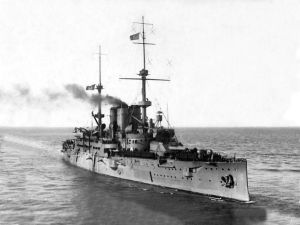 It sank on 20th September 1915 in the port of Brindisi for enemy sabotage.
It sank on 20th September 1915 in the port of Brindisi for enemy sabotage.
454 men of the crew died, including the Commander of the 3rd Naval Division and the Commander of the Ship.
(Characteristics : Displacement 14,974 tons p.c. Speed 20 knots. Protection from 80 mm (bridge) to 220 mm. (artillery). Armament : 4 pieces of 305/40 mm.; 4 pieces of 203/45 mm.; 12 pieces of 152 mm.: 20 pieces of 76 mm.; 2 pieces of 47 mm.; 2 pieces of 37 mm.; 2 gunners of 10 mm., 4 tubes of 450 mm.).
The Battleship at revolving towers Roma, (class Regina Elena), was built in the Arsenal Shipyard of La Spezia to be launched in 1907 and entered into service in 1908.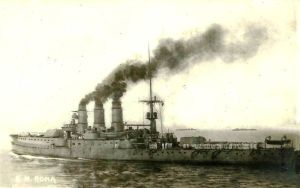
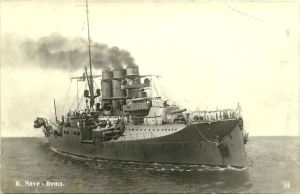 It took part in the Italo-Turkish War and the 1st World War.
It took part in the Italo-Turkish War and the 1st World War.
It was cancelled by the Registers of the Navy in 1928 and demolished in 1932.
(Another image of the Corazzata Roma. The resemblance with Napoli is impressive !).
(Characteristics of the Ship. Displacement and speed the same as the Corazzata Napoli. Protection and Armament the same as the Corazzata Vittorio Emanuele I).
The Destroyer Cruiser Coatit built in Castellammare di Stabia was launched in 1899 and entered service in 1900.
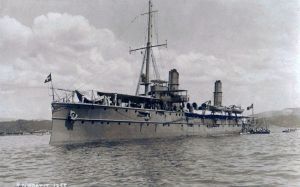 Designed as a Torpedo Destroyer, after modifications made in 1914, it was reclassified as the "Torpedo Destroyer Explorer".
Designed as a Torpedo Destroyer, after modifications made in 1914, it was reclassified as the "Torpedo Destroyer Explorer".
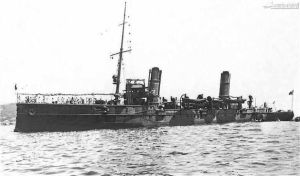 However, due to the low speed developed as an Explorer, it had little success.
However, due to the low speed developed as an Explorer, it had little success.
Originally it was equipped with 2 Trees but later one was removed.
It differed from the twin Unit Agordat because of the shorter funnels. In 1919 it was transformed into Mine cutter ship.
From June 1903 to February 1904 it was deployed in the Red Sea and East Africa to combat piracy.
It took part in the Italo-Turkish War and the First World War. It was disbarred in 1920.
(Features: Agordat Class. P.C. displacement 1.510 tons. Speed 23 knots. Protection 20 mm. (bridge). Armament : 12 single pieces of 76/40 mm.; 2 torpedo tubes of 450 mm.).
The Armoured Cruiser Pisa (twin of Amalfi), was built in the Orlando Shipyards in Livorno and was launched in 1907, entering service in 1911 (before the beginning of the outbreak of the Italo-Turkish War).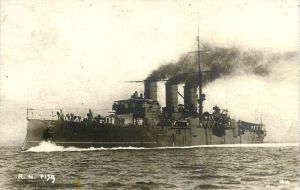 So when he came to Sanremo he had just entered into service.
So when he came to Sanremo he had just entered into service.
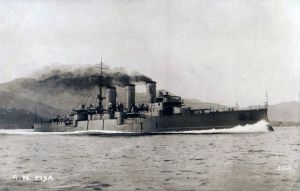 As already said for Amalfi, it was the last generation of large and powerfully armed Cruisers. However, they were soon overtaken by the Battle Cruisers.
As already said for Amalfi, it was the last generation of large and powerfully armed Cruisers. However, they were soon overtaken by the Battle Cruisers.
He took part in the Italo-Turkish War (War of Libya) in 1911.
On 24th May 1915 he was transferred to Venice to support the troops operating on land in that area.
In 1921 it was reclassified as "Corazzata Costiera" (Coastal Battleship) and after modification works it was transformed, from 1925 to 1930, into a school ship for the students of the Naval Academy.
(Characteristics : Displacement p.c. 10,401 tons. Speed 23.3 knots. 51 mm Vickers steel protection. (bridge) to 200 mm. (belt). Armament : 4 twinned pieces IT mod. 1906 from 254/45 mm.; 8 twinned pieces C 1908 from 190/45 mm.; 16 single pieces C 1911 from 76/40 mm.; 2 pieces from 47 mm.; 2 gunners; 3 torpedo tubes from 450 mm.).
Among the 16 Destroyers present in the roadstead there were some in the Soldier Class
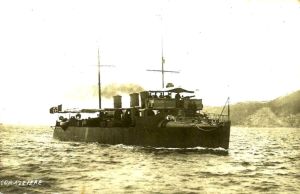 It was a Class designed and built by Cantieri Ansaldo di Genova. Units that were successful, stable, fast and with good manoeuvrability.
It was a Class designed and built by Cantieri Ansaldo di Genova. Units that were successful, stable, fast and with good manoeuvrability.
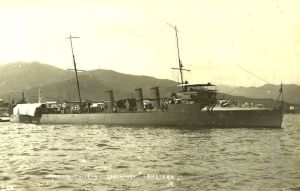 All the Units survived World War I with the exception of the Garibaldi Ship which sank in Villafranca in July 1918 due to a collision with an English warship.
All the Units survived World War I with the exception of the Garibaldi Ship which sank in Villafranca in July 1918 due to a collision with an English warship.
All the remaining Units were downgraded to "Torpedo boats" starting from the 1st July 1921 and disbanded between 1925 and 1930.
Images of the Destroyers Corazziere and Lanciere units of the Class Soldier subclass Artilleryman.
(Characteristic : P.C. displacement 415 tons. Speed : 28.50 knots. Armament : 4 pieces of 76/40 mm.; 3 torpedo tubes of 450 mm.).
(text and images from Dino Taulaigo Collection)




